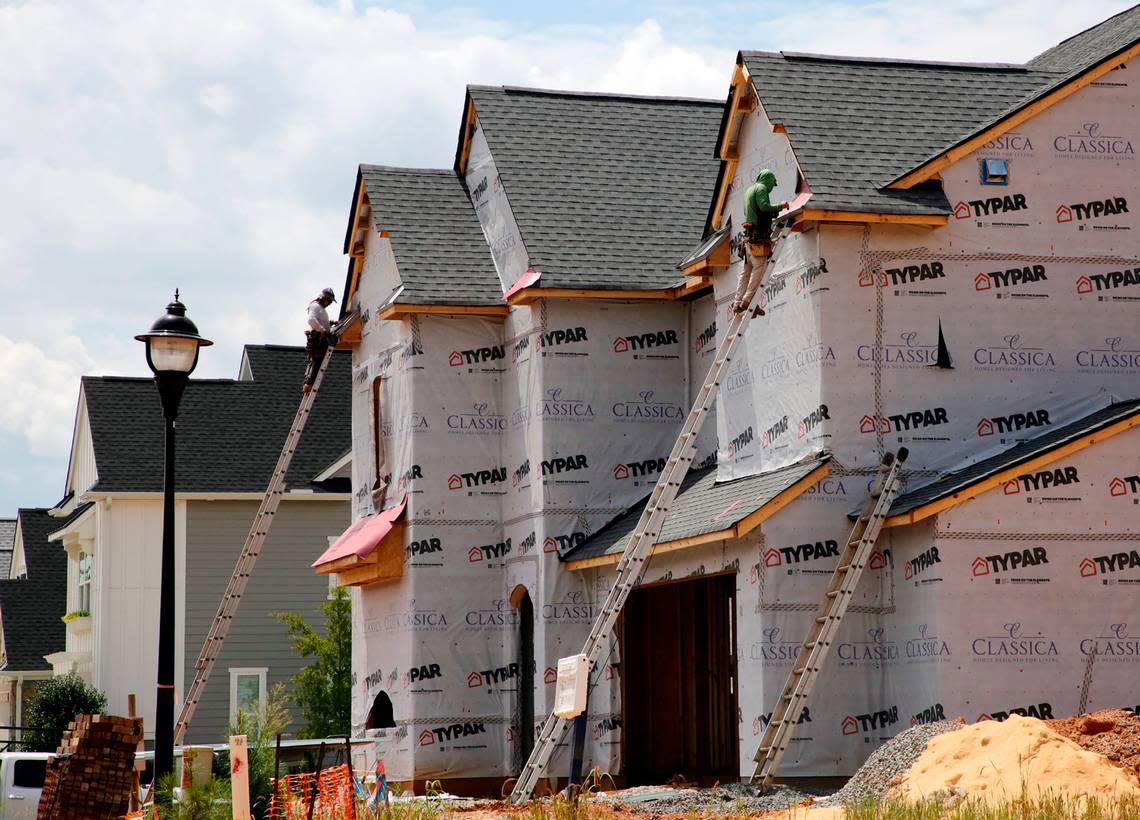New census data shows Fort Mill area is among fastest growing in the Carolinas

The U.S. Census Bureau released new population estimates Thursday that show which Rock Hill region communities are growing and which are shrinking.
Communities like Fort Mill, Clover and Van Wyck continue to add residents. Fort Mill growth rates are unlike others almost anywhere in the country. Yet in about half the cities and towns in three counties, populations are holding flat or even declining.
Here’s a look at how area communities continue to change:
Rock Hill
The census bureau listed 798 incorporated places nationwide that had 50,000 or more residents in 2020. Of them, 402 cities and towns grew in the most recent year. Among York, Lancaster and Chester counties, only Rock Hill meets that population threshold for an incorporated place.
Rock Hill ranked No. 224 on that list with a population growth of .8%. The new estimate of 75,349 Rock Hill residents is up by 606 people in a year. Rock Hill showed the 19th highest growth rate among large municipalities in the Carolinas, and the fifth highest in South Carolina.
Apex, North Carolina had the highest growth in the Carolinas at 3.9% (No. 27 nationally) followed by Columbia at 2.4% (No. 70). Rock Hill’s growth rate trailed several larger Charlotte region municipalities including Mooresville (1.9%), Huntersville (1.8%), Kannapolis (1.7%), Concord (1.7%), Charlotte (1.7%) and Gastonia (1.6%).
In South Carolina, Rock Hill trailed Columbia, Mount Pleasant (1.8%), Charleston (1.2%) and North Charleston (.9%).
In total population, Rock Hill ranks No. 493 in the nation. The city is No. 18 in the Carolinas, and fifth largest in South Carolina behind Charleston (No. 172), Columbia (No. 197), North Charleston (No. 247) and Mount Pleasant (No. 356). Charlotte is biggest in the Carolinas at No. 15 in the nation.
Fort Mill
Fort Mill broke the 30,000-resident mark in the newest estimate. It’s also top five nationally by one growth indicator, for cities and towns its size.
For South Carolina cities and towns, Fort Mill was No. 20 in population as of the 2020 Census. The town was up to No. 18 later in 2020 and in 2021. Last year the town grew to No. 17.
At 30,940 residents, Fort Mill has a growth rate of 10.7% in a year. That’s fourth highest in South Carolina behind three smaller communities (Atlantic Beach, Hardeeville, Moncks Corner), which combined have about 5,000 fewer residents than Fort Mill.
The 26.2% growth rate since the 2020 Census in Fort Mill is third highest in South Carolina, behind Atlantic Beach and Hardeeville.
Among all municipalities in the country, Fort Mill ranks No. 121 in one-year growth and No. 84 since the 2020 Census. For communities that had 20,000 or more residents in the last census, Fort Mill is No. 5 nationally in growth. Fort Mill is No. 11 on that same list for one-year growth.
Of note, a significant and often even higher growth rate portion of Fort Mill isn’t reflected in those numbers. Fort Mill has a significant population outside town limits, but with Fort Mill addresses. Baxter, the Carowinds area and properties heading toward Tega Cay call themselves Fort Mill but aren’t part of municipal population counts.
York County
Behind Fort Mill, York County’s newest hot spot among municipalities is Clover. Clover has an estimated 7,405 residents. In a year, the 6.5% increase is No. 12 statewide. Only Atlantic Beach (No. 1) and Blythwood (No. 5) have fewer residents than Clover but are among the top 12.
Since the last census, Clover is No. 10 among South Carolina municipalities with a growth rate of 10.9%.
Tega Cay now has an estimated 13,689 residents. The growth 3.1% one-year growth rate is No. 29 statewide. The 6.6% increase since the census is No. 22.
Rock Hill is No. 99 in one-year growth and No. 106 in growth since the last census, statewide.
The city of York is an anomaly. Despite significant residential construction permitting growth in the area that’s prompted road and school concerns, the census data lists York with a population drop of five people in a year, to 8,648 residents. The population is still up 1.8% since the census, No. 88 statewide in that span.
Smyrna is up one resident in the latest estimates. McConnells, Hickory Grove and Sharon are up two residents in a year.
Lancaster, Chester counties
Lancaster is the largest city in our region outside York County, at 8,829 residents. Next comes Chester at 5,187 residents, Great Falls at 1,914 residents and Kershaw at 1,843 residents.
The highest percentages of one-year growth from Lancaster and Chester county municipalities came from Van Wyck (4.2%), Kershaw (4%), Heath Springs (3.8%) and Lancaster (2.3%). Lowrys had no growth while Fort Lawn (-.1%), Chester (-.7%), Great Falls (-.8%) and Richburg (-.1%) had population drops.
Since the last census, the highest growth came from Van Wyck (10%), Kershaw (9.2%), Heath Springs (8.5%) and Lancaster (3.8%). Municipalities that dropped in population were Fort Lawn (-.2%), Lowrys (-1.1%), Chester (-1.2%), Great Falls (-1.8%) and Richburg (-2.5%).
Indian Land, Lake Wylie
Two high-growth areas, including Indian Land which in recent years outpaces the entire region, aren’t reflected in the new figures. Indian Land and Lake Wylie, respectively in Lancaster and York counties, are unincorporated. So they aren’t among the municipal figures.
There have been past efforts in both places to become a city or town, including a public referendum that was held in Indian Land. Population increases in those areas contribute to countywide figures. There are similar areas, like the part of unincorporated York County between Fort Mill and Tega Cay where a large part of York County’s growth is centered.

